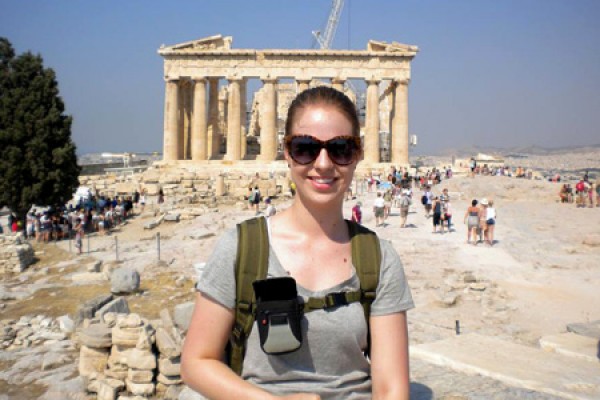 Kala Bechard stands at the Athenian Acropolis in front of the ancient Greek Parthenon. She was one of about a dozen students who spent about a month in Greece this summer.
Kala Bechard stands at the Athenian Acropolis in front of the ancient Greek Parthenon. She was one of about a dozen students who spent about a month in Greece this summer.
Studies into ancient civilizations came to life this summer for a group of students who got to travel to the site of a Greek city destroyed more than two thousand years ago, and which was at one time, considered only a legend.
“You can see the things that are in your text book right in front of you,” said Ethan Dow, one of about a dozen students in classical civilization professor Robert Weir’s fourth-year practicum course who traveled to Helike, Greece this summer. “You’re holding what you’ve been studying.”
Helike was a Bronze Age city of about 2,000 people that disappeared around 373 BC as a result of an earthquake and accompanying tsunami. It was thought to be legend until 2001, when it was discovered by a team of scientists who began to search for it in 1988 with a systematic sonar survey of the seafloor southeast of the Aegean Sea. Thanks to the use of surface surveys, geophysical exploration, borehole drilling, and some very specific coordinates from the ancient writer Pausanias, they eventually found that it was not under water, but on the adjacent coastal plain.
The students were in Greece for about a month and the first part of the trip was spent traveling around the country visiting museums and other historic sites. One of those was the well-known Agora excavations in Athens, were they spent time visiting with Jeff Banks and Andrew Sparling, two University of Windsor graduates who are currently working there.
The last two weeks, however, were spent participating in the ongoing archaeological dig at Helike, a nine-acre site that was included on the World Monuments Fund List of 100 Most Endangered Sites both in 2004 and 2006.
The city was home to a textile mill, and to date, archaeologists and volunteers – many from Weir’s class who have traveled there on previous excursions – have dug down about three metres, unearthing foundation walls and various other structures, roof tiles, and basins for washing and drying textiles.
“They showed us what to do when we got there, but it was very independent,” said Kala Bechard, a concurrent education and history student who was on the excursion.
Under the intense heat of the Greek sun, the students used hoes, trowels and pick axes, painstakingly clearing away dirt mere centimeters at a time. And while the work could be exhausting, it was also exhilarating, especially for Dow, who found several pieces of ancient pottery.
“I got really excited when I found that,” he said. “It was just a beautiful piece. You’re finding these plates and cups that were there thousands of years ago. It’s hard to describe.”
After going on the trip, the students have to write a paper as part of their course work about what it would take to transform the privately owned site in to a fully functioning tourist attraction, as well as create a brochure about it.
“It’s addicting,” Bechard replied when asked to describe the experience. “I want to go back already. It’s hard work, but lots of fun.”
View a photo gallery from the students' trip.

Ethan Dow holds up one of the relics he found at the Helike dig site in Greece.

Editor's note: this is one of a series of articles about students who were engaged in cool research projects and other scholarly activities this summer.
